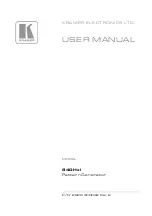
OWNERS MANUAL FOR WEISS DAC202 D/A CONVERTER
Page
8
Date: 03/10
(DSP)) ahead of the final D/A conversion (the D/A chip),
while oversampling means the change in sampling rate
employed in today’s modern D/A converter chips
themselves.
But let’s start at the beginning. What is the sampling
frequency? For any digital storage or transmission it is
necessary to have time discrete samples of the signal
which has to be processed. I.e. the analog signal has to
be sampled at discrete time intervals and later converted
to digital numbers. (Also see "Jitter Suppression and
Clocking" above)). This sampling and conversion process
happens in the so called Analog to Digital Converter
(A/D). The inverse in the Digital to Analog Converter
(D/A).
A physical law states that in order to represent any given
analog signal in the digital domain, one has to sample
that signal with at least twice the frequency of the
highest frequency contained in the analog signal. If this
law is violated so called aliasing components are
generated which are perceived as a very nasty kind of
distortion. So if one defines the audio band of interest to
lie between 0 and 20 kHz, then the minimum sampling
frequency for such signals must be 40kHz.
For practical reasons explained below, the sampling
frequency of 44.1kHz was chosen for the CD. A
sampling frequency of 44.1kHz allows to represent
signals up to 22.05kHz. The designer of the system has
to take care that any frequencies above 22.05kHz are
sufficiently suppressed before sampling at 44.1kHz. This
suppression is done with the help of a low pass filter
which cuts off the frequencies above 22.05kHz. In
practice such a filter has a limited steepness, i.e. if it
suppresses frequencies above 22.05kHz it also
suppresses frequencies between 20kHz and 22.05kHz to
some extent. So in order to have a filter which
sufficiently suppresses frequencies above 22.05kHz one
has to allow it to have a so called transition band
between 20kHz and 22.05kHz where it gradually builds
up its suppression.
Note that so far we have talked about the so called anti-
aliasing filter which filters the audio signal ahead of the
A/D conversion process. For the D/A conversion, which is
of more interest to the High-End Hi-Fi enthusiast,
essentially the same filter is required. This is because
after the D/A conversion we have a time discrete analog
signal, i.e. a signal which looks like steps, having the
rate of the sampling frequency.
Such a signal contains not only the original audio signal
between 0 and 20kHz but also replicas of the same
signal symmetrical around multiples of the sampling
frequency. This may sound complicated, but the essence
is that there are now signals above 22.05kHz. These
signals come from the sampling process. There are now
frequencies above 22.05kHz which have to be
suppressed, so that they do not cause any
intermodulation distortion in the amplifier and speakers,
do not burn tweeters or do not make the dog go mad.
Again, a low pass filter, which is called a „reconstruction
filter“, is here to suppress those frequencies. The same
applies to the reconstruction filter as to the anti-aliasing
filter: Pass-band up to 20kHz, transisition-band between
20kHz and 22.05kHz, stop-band above 22.05kHz. You
may think that such a filter is rather "steep", e.g.









































